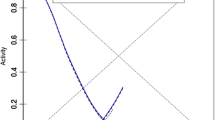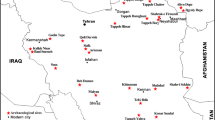Abstract
The chemical composition of ancient copper-based metal changes over time due to repetitive recycling and mixing of old metal. Prehistoric copper usually contains impurities from the copper ores themselves, and some have been used as evidence of anthropomorphically induced chemical change. Research into these changes has historically relied upon the assumption of element loss linearity, which is highly misleading and in fact varies with a multitude of factors. To illustrate the complexity of such losses for prehistoric alloys, we have selected arsenical bronze (Cu-As alloys) for study. The mass loss of several Cu-As-alloys under reducing atmosphere was measured by DTA/TGA. From our comparison of the experimental results to thermodynamic calculations and literature data, it was unclear whether weight losses were solely caused by the elemental loss of arsenic. However, a prolonged time temperature-cycling run demonstrated that mainly arsenic volatilizes; hence, the non-linear mass loss from the alloy can be directly attributed to arsenic.







Similar content being viewed by others
References
Bray PJ, Pollard AM (2012) A new interpretative approach to the chemistry of copper-alloy objects: source, recycling and technology. Antiquity 86:853–867
Bray PJ, Cuenod A, Gosden C, Hommel P, Liu R, Pollard AM (2015) Form and flow: the ‘karmic cycle’ of copper. J Archaeol Sci 56:202–209
Caley ER (1964) Orichalcum and related ancient alloys: origin, composition and manufacture with special reference to the coinage of the Roman Empire. The American Numismatic Society, New York
Chernykh EN (1972) Ancient metallurgy in the USSR: the early metal age. Cambridge University Press, Cambridge
Dungworth DB (1996) Caley’s ‘zinc decline’ reconsidered. Numismatics Chronicle 156:228–234
Härke H (1978) Probleme der optischen Emissionsspektralanalyse in der Urgeschichtsforschung. Prähistorische Zeitschrift 53:165–276
Haubner R, Ertl F, Strobl S (2017) Examinations of a bronze ingot made of fahlore. Pract Metallography 54:107–117
Hodson FR (1969) Searching for structure within multivariate archaeological data. World Archaeol 1:90–105
Jochum-Zimmermann E, Senn EM, Wichser A (2005) Zum Verhalten von Spurenelementen und Legierungsbestandteilen in Kupfer bei der Weiterverarbeitung des Metalls. Experimentelle Archäologie in Europa Bilanz 2004(3):127–136
Junghans S, Sangmeister E, Schröder M (1968–1974) Kupfer und Bronze in der frühen Metallzeit Europas, Gebr. Mann, Berlin, (4 volumes)
Krause R (2003) Studien zur kupfer- und frühbronzezeitlichen Metallurgie zwischen Karpatenbecken und Ostsee. Leidorf, Rahden
McKerrell H, Tylecote RF (1972) The working of copper-arsenic alloys in the Early Bronze Age and the effect on the determination of provenance. Proc Prehist Soc 38:209–218
Mödlinger M, Sabatini B (2016) A re-evaluation of inverse segregation in prehistoric Cu-As objects. J Archaeol Sci 74:60–74
Pernicka E (1990) Entstehung und Ausbreitung der Metallurgie in Prähistorischer Zeit. Jahrbuch Römisch-Germanisches Zentralmuseum 34:607–714
Pernicka E (1999) Trace element fingerprinting of ancient copper: a guide to technology or provenance? In: Young SMM, Pollard AM, Budd P, Ixer RA (eds) Metals in antiquity. BAR International Series 792 (Oxford 1999) 163–171
Plascencia G, Utigard T (2003) In: Kongoli F, Itagaki K, Yamauchi C, Sohn HY (eds) Metallurgical and materials processing: principles and technologies (Yazawa International Symposium), volume 2, high-temperature metal production, 359–369
Pollard AM, Bray PJ (2014) Chemical and isotopic studies of ancient metals. In: Roberts BW, Thornton CP (eds) A global perspective in early metallurgy. Springer, New York, pp 217–237
Pollard AM, Bray PJ (2015) A new method for combining lead isotope and lead abundance data to characterise archaeological copper alloys. Archaeometry 57(6):996–1008
Pollard AM, Bray PJ, Gosden C (2014) Is there something missing in scientific provenance studies of prehistoric artefacts? Antiquity 88:625–631
Redlich O, Kister AT (1948) Thermodynamics of non-electrolyte solutions, x-y-t relations in a binary system. Ind Eng Chem 40:341–345
Sabatini B (2015) The Cu-As-Ni system: a chemical thermodynamic model for ancient recycling. JOM 67(12):2984–2992
Subramanian BR, Laughlin DE (1988) Bull Alloy Phase Diagr 9/5:605
Voisin LA (2012) Distribution of precious metals during the reducing pyrometallurgical processes of complex copper materials, noble metals. In: Yen-Hsun S (ed) InTech. Available from: http://cdn.intechopen.com/pdfs/27198.pdf (February 2017)
Yazawa A, Nakazawa S (1998) Evaluation of non-equilibrium minor components in pyrometallurgy. EPD Congress:641–655
Funding
This work was supported by the European Union’s Horizon 2020 research and innovation program under the Marie Skłodowska-Curie Actions [grant no. 656244].
Author information
Authors and Affiliations
Corresponding author
Rights and permissions
About this article
Cite this article
Mödlinger, M., de Oro Calderon, R. & Haubner, R. Arsenic loss during metallurgical processing of arsenical bronze. Archaeol Anthropol Sci 11, 133–140 (2019). https://doi.org/10.1007/s12520-017-0534-1
Received:
Accepted:
Published:
Issue Date:
DOI: https://doi.org/10.1007/s12520-017-0534-1




